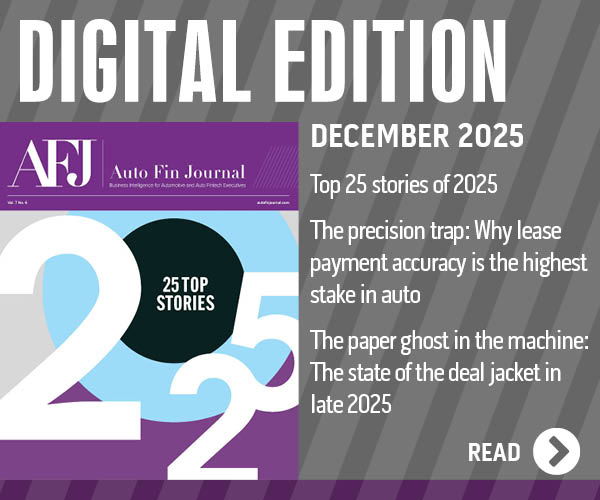COMMENTARY: Winning insights for electric-vehicle financing

By subscribing, you agree to receive communications from Auto Remarketing and our partners in accordance with our Privacy Policy. We may share your information with select partners and sponsors who may contact you about their products and services. You may unsubscribe at any time.
NEW YORK –
Formula E has lessons for auto-finance companies as they transform.
In Formula E, the world’s first fully electric, international racing championship, data is helping drivers win races. For our partner, Envision Virgin Racing, a founding Formula E team, it’s crucial at every stage — from car design to race-day performance. Actionable insights from data, which are shared between the car and its driver on the track and engineers and strategists in the control room, provide drivers with a critical advantage in races that are often decided by milliseconds.
But this approach isn’t uniquely useful in the sharp end of motor racing entertainment. It’s also essential in enterprise — in particular, in the transformation of the auto finance industry from selling combustion vehicles to financing electric vehicles (EVs).
A successful past and an uncertain future
EVs are the future of mobility and transportation, of safety on the road, and a major step towards tackling the climate crisis. But time for the industry to transform to its electric future before tech giants take over is running out.
There are serious challenges to financing, though. For example:
● There is currently no economically-viable business case. Case in point? Tesla is still selling cars below cost
Subscribe to Auto Remarketing to stay informed and stay ahead.
By subscribing, you agree to receive communications from Auto Remarketing and our partners in accordance with our Privacy Policy. We may share your information with select partners and sponsors who may contact you about their products and services. You may unsubscribe at any time.
● The level of initial investment required to sell EVs at scale is very high
● The industry lacks expertise in artificial intelligence, machine learning, and data analysis all of which will be critical to the success of the EV market
● The shift to EVs is part of a broader paradigm shift from analog to digital, which means the entire business model will need to change
Like their Formula E counterparts, however, auto lenders can use data to power through uncertainty. Specifically, they must use data to:
• Update the business model
• Extract maximum value from both customer relationships and vehicles
• Focus on the customer to drive advocacy
• Take calculated risks to win
Update the business model
Like other industries, the auto market is shifting from ownership to use, and from financing assets to providing services that flow from them. Today, drivers want options besides just buying and owning a car. They want to subscribe to a variety of vehicle types, have access to a car for just the weekend, buy vehicles bundled with insurance or other add-ons, and more. These are new needs that demand a new business model.
Auto lenders can’t predict exactly what’s going to happen – like a Formula E race, there are just too many variables. But they can learn from the Envision Virgin Racing team by collecting data to predictively model ‘what if’ scenarios that will help shape the strategies that will transform their business model. For example, they can collect data from connected combustion cars and feed it into their models for electrification. And they can develop strategic partnerships to obtain expertise in value-add services, such as insurance and maps.
Use lifecycle data to extract maximum value
Today’s auto finance model is focused on depreciation in the value of the asset – something lenders understand well. But with EVs, a great deal about depreciation remains unknown. For example, companies know relatively little about how EV batteries age, the decline in their performance over time, and their consequent resale value. So, working out a finance model for majority electrification across all markets, models, and countries is tricky.
Tricky or not, if customer needs and the business model are changing, then the finance model must change too. Instead of continuing to focus on depreciation, auto lenders must now focus on obtaining and analyzing data from the whole lifecycle of the vehicle to extract maximum value from both the customer relationship and the asset itself. This includes using artificial intelligence and machine learning to tap current and potential data sources in connected cars. This, in turn, will enable auto lenders to:
• Evaluate the actual use of each vehicle to accurately predict its second-hand value, or the price-equity point
• Conduct predictive maintenance, so they can sell finance plans to customers based on no- or low-fault vehicles
• Understand the local conditions for second-hand sales to maximize the vehicle’s commercial lifespan
Auto lenders need to use new and existing sources of data, combined with human judgement, as the bedrock of their strategy. And, like Envision Virgin Racing, they must hire or partner with experts who can help extract insights from that data to drive performance in what will soon be a very competitive market.
Focus on the customer
Part of mass electrification is down to engineering, but part is marketing. To improve customer experience and drive widespread adoption of EVs, the customer must be incentivized.
Unlike any other sport, Formula E allows its fans to play a role in the outcome of the event. By engaging with the race on select apps, fans can vote to award power boosts to drivers, which the drivers can use in the second half of the race. Auto lenders can learn from this approach. Instead of focusing on the vehicle as an engineering asset, they should shift their focus to the customer as an advocate.
The combustion customer model is built on a very limited amount of data sharing between car, customer, and company. With highly connected EVs, however, auto lenders can extract, analyze, and act on large amounts of data to, for example:
• Make better credit decisions
• Offer dynamic pricing models
• Provide real-time, real location, reactive insurance
• Pinpoint the best time for renewal or replacement
If the business model becomes one of frequent touchpoints with customers, in both their digital and physical worlds, auto lenders will find themselves in possession of all the information they need to transform their business model and drive their business performance. Engaging customers and placing them, rather than the asset, at the center of the relationship will lead to better deals and encourage customers to become advocates.
Take calculated risks to win
In Formula E, drivers can be rewarded with a 25-kilowatt power boost by entering attack mode and deviating from the racing line. This is a high-risk, high-reward strategy. Similarly, auto lenders can achieve a competitive advantage by using data to seek out different lines of attack that enhance decision-making and performance in their businesses. But doing so will require them to update the business model, partner effectively to extract value from data, and focus on the customer to drive advocacy.
It’s time to put the pedal to the metal and transform with data.
Rohan de Souza is the global head of auto finance at Genpact, and Amaresh Tripathy is the global business leader of analytics at Genpact.


